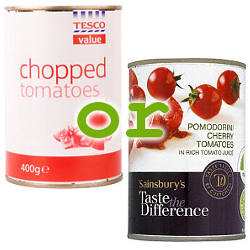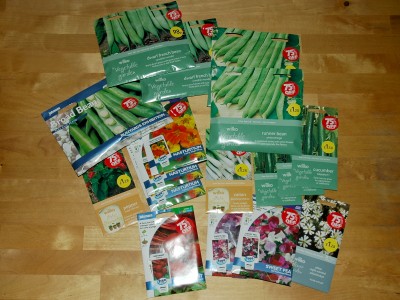Is it easier to be super frugal as part of a couple or as a single person?
I was thinking about this question the other day – is it easier to be super frugal as part of a couple or as a single person? – but I think I should immediately clarify that while I’m interested in hearing people’s thoughts on it, I have no intention of leaving my lovely boyfriend if single “wins”! :)
It generally is cheaper, of course, to be part of a couple – often two incomes coming in but many living costs don’t go up (or don’t go up that much) so regular outgoings on bills are roughly halved. Two people who like spending time together don’t generally need a bigger house/flat than one person; insurance costs don’t really go up when there are two of you; utility bills might go up a bit and council tax will go up when you lose your single person discount – but since you’re sharing it, you’ll be paying less overall.
But while it’s cheaper in general, in my experience, having to consider the other person in the relationship can make it more difficult to be frugal in other parts of your life. I’ve noticed that when the two of us are home at the same time, we’re more likely to put the heating on/light the stove than if there is just one of us there (especially if that one of us is me). Similarly, our meals tend to be more extravagant when we’re both eating than when we’re dining solo – dinner becomes an event which necessitates a proper meal rather than just quick’n’easy snack that will more than suffice. Similarly, John doesn’t expect for me to live in a fashion show but I think I’d probably be even scruffier/pyjama-clad around the house than I am now if my only audience was feline/canine.
John and I are generally on a very similar wavelength when it comes to (not) spending money and that sort of thing but, for example, he buys more expensive bacon than I would or is more likely to put the heating/stove on before me when it’s chilly (he’ll put a jumper & socks on first, of course, but I’d be more likely to get under a blanket too). I’m fussier when buying home furnishings (fabrics, colours etc) so spend more money on that sort of thing than he ever would. John also earns considerably more than me (because he’s in a higher paid profession and works more hours) but even though we largely pool our money, our income disparity means we have different opinions on what is affordable and what isn’t because the same amount of money represents a lot more time worked for me than it does for him.
Basically, I think we’re both much happier to “make do” when we’re home alone. When both of us are here, we settle at a higher unspoken comfort level to possibly avoid upsetting the other unnecessarily.
That might just be us though – I’d love to hear what you think from your experiences.
If you’re in a relationship/have a family at home, do you & your partner/kids have the same frugal outlook? Does it cause any problems? Do you have to compromise on anything? If you have different frugal levels/requirements, how do you make it work?
If you’re single, do you have any habits that you think you’d change if you were living with someone else?
Read More“Value” or “Taste the Difference”?
 This month’s Which magazine* includes a section about supermarket food prices (apparently 57% of people are looking for reduced price food more now than they were a year ago, and 60% are using offers more – but 43% think most supermarket promotions are on unhealthy food) and an article about whether we should pick the value version, the standard one or the premium brand of various food products.
This month’s Which magazine* includes a section about supermarket food prices (apparently 57% of people are looking for reduced price food more now than they were a year ago, and 60% are using offers more – but 43% think most supermarket promotions are on unhealthy food) and an article about whether we should pick the value version, the standard one or the premium brand of various food products.
The Which people compared the prices and made relevant ingredient comparisons (eg, the amount of meat in a lasagne ready meal) between each of the different levels, and also did taste tests.
I obviously won’t type out the whole article here but they did recommend the budget option for: butter, natural (not fruit) yogurt, frozen peas, spaghetti and for use when cooking stews etc, carrots, frozen fish, cheddar cheese, kidney beans and tinned tomatoes.
And they suggested the following premium products were worth splashing out on: bacon (less water), beef mince (less fat), sausages (less bulking agents), ham (less water/additives) and ready-meal quiche. They added that you should go premium or at least standard on teabags, fruit yogurts, cornflakes and ready meals like lasagne.
Funnily enough, this roughly matches where we spend our money – John has a thing about expensive bacon & sausages but we’re happy with cheap yoghurt and butter, and use budget carrots and cheese for cooking.
One thing I’d possibly disagree on is the tomatoes: I find the cheapest ones tend to include a lot of “stalk” ends (not a problem in a curry, more of a problem in a quick sauce) and more citric acid & other acidic preservatives (John has an intolerance to lots of acids like that), so we tend to go for standard or premium ones if they’re on offer so as cheap as standard.
Aside from the things they looked at, I often buy value plain flour for basic baking (especially for dusting) and in the non-food sphere, the cleaning products I buy (including washing powder) tend to be the basic range too. Back in the day, when we used to buy them frequently, I also used to rate value oven chips over branded ones. We also buy a lot of super cheap brand stuff – the cost equivalent of value brands, just not from the major supermarkets – like rice, vegetable oil and pickled vegetables or chutneys (mostly from shops specialising in Asian or Mediterranean food stuffs).
Having said that, a peek into our cupboards to “research” this post showed me that by far the most common label is Morrisons standard own brand. I know from experience that most things were bought on offer so they’d have been cheaper or about equal to the budget brands – but bearing in mind Which’s findings, I think we could swap to budget in a few more areas.
What do you think? Do you always go for one product class or mix and match for different things? Do you actually prefer the value option of anything? And is there anything you always pick premium for?
I would love to hear people’s value product recommendations – and ones where the extra money really is worth it for premium!
* I don’t buy Which magazine, or any magazines, regularly but signed up for a subscription in June when we were buying a few things for the house. I don’t swear by Which but lacking any other up-to-date information sources, we thought it was worth at least checking out. I like that Which is about buying quality items that will last; I dislike that it promotes consumption, often in the form of gadgets – whenever John & I read it, we both feel “well, maybe I do need a new camera…” pangs. Baaaaaaaad.
Read MoreExtreme frugality – a good thing or a bad thing?
 Extreme frugality worries me. I’m not talking about when people have to do it from absolute necessity – when they have no other choice because either their kids will starve or they’ll immediately lose their home etc. I mean when already frugal people declare they’re going to tighten their belts to a supermodel-thin level by choice – as various frugal living bloggers do from time to time.
Extreme frugality worries me. I’m not talking about when people have to do it from absolute necessity – when they have no other choice because either their kids will starve or they’ll immediately lose their home etc. I mean when already frugal people declare they’re going to tighten their belts to a supermodel-thin level by choice – as various frugal living bloggers do from time to time.
Of course, personal reduction challenges can be useful in themselves or very interesting as self-reflection exercises. They can help break bad habits, force you to try new things (dried pulses can be fun!) or reveal things about yourself. A great example of this is Consumption Rebellion‘s $2 a day food challenge – it was fascinating to see how quality of food can affect someone in the short term as well as the well known health effects in the long term.
“How low can you go” can be interesting too – watching as people reduce their outgoings by choosing cheaper alternatives or cutting out luxuries – but at the same time, I worry that it can become a one downmanship game, an unspoken “you have to be –> this frugal to be a frugal blogger” competition. I also worry that with some people, there is a martyrdom aspect to their new “extreme” path, as if they’re trying to atone for previously spendthrifty behaviour. They wear their extreme frugality as a hair shirt.
Most importantly though, I worry that general extreme frugality is like a short-term extreme diet. Everyone knows those diets are bad news – that they’re more likely to result in bingeing behaviour at weak spots and people tend to regain all the weight lost, and more. Extreme frugality doesn’t seem sustainable and could impact their (and their families) general attitude to frugal living.
Perhaps I’m being unfair. Obviously “extreme” is a very subjective term and what I might think of as “extreme” frugality isn’t what the people doing it think – although from descriptions, I suspect there is some overlap.
I also suspect it very much depends on the individual’s goals/priorities. My priority is kinda indicated in the blog’s title (and certainly on the About page) – I want to live well on a budget rather than super-frugally because I’m really interested in the ongoing journey not the destination. Admittedly part of that is because I don’t have to live super-frugally – we have enough money for our day to day living, aren’t having to save for anything in particular at the moment and don’t have debts (other than a mortgage) to pay off — but even if I was saving furiously/paying off debts, I think I’d prefer to have a slightly larger amount to spend day to day and less going into savings/debt relief – I want to enjoy my life, to live a really good life. While I suspect it’s easier for me to say this now than if I was living it (life with debt is scarier than most debt-free people think), I’d rather spend a little longer paying off those debts than be miserable and potentially risk my health in the meantime. Perhaps that’s just me though, and I’m worried about “extreme frugal” stints because it’s something I would be reluctant to do, without a very good immediate reason.
What do you think about “extreme frugality”? Have you given it a go at any point? What was your experience? Do you think my worries are unjustified? Do you think I’m being unfair?
I’d love to hear other people’s opinions on this.
(Photo by sufinawaz)
Read MoreHow we got 14 meals from our Swillington Farm chicken
We got our first Swillington Farm meat box delivery at the end of June and are determined to do it justice. I’m keeping a lengthy record of what we did with every bit of it – but as we’ve not got through much of it so far, I thought I’d mention this separately – what we did with the chicken.
As part of our “medium” box, we get “1x large organic chicken” each month. By “large”, they mean large – it was considerably bigger than any I’ve seen for sale at supermarkets. According to the Swillington Farm’s website, the birds start indoors but then “spend the next 2 months free range on organic pasture” and “aged at least 3 months before they reach your plate [producing] larger, better tasting chickens than the average supermarket bird” (supermarket chickens are typically 6-9 weeks in age when they’re killed – ie, 1.5-just over 2 months old). Butchered, our Swillington chicken weighed 2.6kg (5lb 12oz), and they included the liver & neck in a little baggie.
How we used it
- 2 portions: Chicken legs (each weighed close to 370g!) roasted with a light garlic, lemon, ground coriander & black pepper marinade. Cooked with roasted new potatoes, and served with purple sprouting broccoli.
- 2 portions: Chicken wings and some meaty bits from the carcass roasted with the same marinade, with leftover roasted potatoes and garlicky broad beans & salad from the garden.
- 4 portions: Chicken & sweetcorn noodle soup made from stock/meat from the carcass/neck.
- 3 portions: Chicken jalfrezi, made with one chicken breast and our eggs.
- 3 portions: Chicken & pepper jalfrezi, made from the other breast and our eggs.
And the cats had the skin & liver cooked up and blended into a “pate” – which they *loved*.
We have … generous appetites so the portions were still quite large – both in the amount of chicken in each portion and the size of the portion. I thought there was enough meat in all the meals – all the meals felt sufficiently chicken-y for me – but John said he’d have liked a better chicken-to-other ratio in the first jalfrezi.
Update – Jan 2013: We’ve had Swillington Farm meat boxes most months since I wrote this post and we’ve always had equally generous chickens – including some even bigger ones at times! 14 meals from a bird is the rule in this house, not the exception – and 16 meals isn’t uncommon. I’ve written a little update here.
What are your favourite ways to get the most out of chickens?
Read More75% off seeds at Wilkinsons
It feels a bit early (in general and earlier than last year) but various shops have started selling off their sow-by-2012 seeds cheaply.
I was near a Wilkinsons yesterday (I heart Wilkinsons – I nearly wet my pants when they opened a big store down the road from our old house in Leeds and it’s one of the things I miss most about living in Leeds. #sadconfession) and popped in to peruse their packets — all 75% off in store (they seem to be 3 for 2 on the website). I went a bit mad at first and ended up putting about a dozen of them back but I did buy…
That’s:
2 x dwarf french beans (Canadian wonder – 120 seeds per pack) = £0.25 a pack
2 x runner bean (white emergo – 40 seeds per pack) = £0.32 a pack
1* x broad beans (Bunyards exhibition – 50 seeds) = £0.56 a pack
3 x nasturiums (trailing single mixed – 35 seeds per pack) = £0.49 a pack
1 x onions (bunching ishikura – 375 seeds) = £0.32 a pack
1 x pepper (“sweet” mini red – 50 seeds) = £0.32 a pack
1 x beetroot (boltardy – 275 seeds) = £0.37 a pack
3 x cucumber (telepathy F1 – 5 seeds per pack) = £0.39 a pack
1 x phlox night scented (200 seeds) = £0.32 a pack
2 x sweet pea (mixed – 25 seeds per pack) = £0.56 a pack
So 17 packs of seed for £7.35, rather than nearly £30 – I’m quite happy with that.
* I would have bought more of these even though they’re branded so more expensive, but this is all they had
Combined with the (18) free packets I’ve collected one way or another this year, and what I’ve haven’t used this year and the seeds I’ll save from my Real Seeds purchases this year (achocha, special peppers etc), I think I’m about all set on the seeds front for next year already – perhaps some more broad beans (as they’ve been fab this year), some courgettes (as I don’t have much luck saving seeds due to being hybrids/cross-pollination, and we heart courgettes) and some basil, but that’ll be it. Hurrah! :)
Apparently Dobbies and the super cheap supermarkets (Aldi/Lidl etc) are heavily discounting their seeds at the moment too.
Have you started buying seeds for next year too? Have you spotted any other seed bargains out there?
Read More




